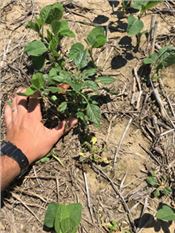Reports Of Poor Palmer Amaranth Control With Dicamba
DR. LARRY STECKEL
JACKSON, TENN.
The worst kept secret in West Tennessee has been the reports of poor Palmer amaranth control with Engenia in a field in Fayette County.
This was one of the first if not “the” first Engenia sprayed POST to soybeans in the state so there was a lot of interest. Unfortunately, the Palmer control was sketchy in spots.
I visited the field Friday which was 19 days after a tankmix of 12.8 ozs of Engenia + 32 ozs Roundup PowerMax + 2 ozs of Zidua had been applied POST to the soybeans. The Palmer amaranth at the time of application ranged mostly from 2” to 4” tall with a few closer to 6”.
This field had only been in row crops for a couple years and as such was not covered in Palmer amaranth. The overall weed control in the field was good. However, in a couple areas where it looked like some mother Palmer plants went to seed last year only about 50 percent of the Palmer amaranth were controlled.
These survivors were twisted and most had not grown since the time of application. Other than a few pigweed that did appear to be putting out some new growth pretty much all the surviving Palmer were at the same height as the day they were sprayed.
I have seen this in research, though not often, with pigweed under 4” and never with 50 percent of the population. In our research with Engenia and Xtendimax applied to pigweed 4” tall or more, some pigweeds would not die. These survivors would show a good bit of twisting. These survivors also would not grow for a couple weeks and then about 14 to 20 days after application, they would start to put out new growth. In our research, a sequential application of either Engenia, Xtendimax or Liberty (in Xtend cotton) about 14 days after the first dicamba product application removed all the crippled pigweed.
In the Fayette county field we sprayed a sequential application of 12.8 oz/A of Engenia 14 days after the first application with a hand boom on the survivors. By 5 days after the sequential application the Palmer amaranth appeared to be going down. We also applied 1.5 pts of Flexstar to the survivors and by 5 days after application it was readily apparent they all were resistant to PPO herbicides.
So is the PPO resistance in Palmer amaranth increasing the tolerance to dicamba? I do not know. There is on-going research to evaluate if there is a linkage but at this point it is only a theory.
What I can say is that the perception many have that dicamba will control Palmer amaranth like Roundup did in 1996 is causing a lot of disappointment. Just today a farmer in Gibson county was surprised that he needed to apply Liberty to remove pigweed that had escaped dicamba. Weed scientist in Arkansas have been fielding reports of inconsistent pigweed contol with dicamba. This past week, my colleague from the University of Georgia told me that he has had reports of sketchy Palmer amaranth control with dicamba products as well. It should be noted that Georgia does not have documented PPO-resistant pigweed.
So how do we manage escaped Palmer amaranth? In cotton a great follow up application to dicamba to take out any surviving pigweed is Liberty. In soybeans the only option is either Engenia or Xtendimax. Finally, if you want to have a chance to get good Palmer amaranth control with one Engenia or Xtendimax application target 1 to 2” Palmer. If you wait until some pigweeds are 4” tall, plan on having the sprayer back to the field in two weeks to work on the escapes. ∆
DR. LARRY STECKEL: Extension Weed Specialist, University of Tennessee
 14 DAA Engenia and Roundup
14 DAA Engenia and Roundup